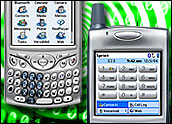
Handset vendors have been frantically trying to innovate in an effort to keep their products from becoming commodity items. Consequently, they have incorporated a number of new features into their products, such as cameras, and are offering slim, sleek designs available in a variety of colors. Now, their ongoing quest is leading them into a new area: scanning.
Just as printers and digital cameras eventually added scanning functions, cell phones appear to be the next candidates to include that capability. “There are some rudimentary scanning functions now available in cell phones and those features should improve over time,” said Kenneth Hyers, principal analyst of mobile wireless research at ABI Research.
Easy Transition
Once a phone is outfitted with a camera, the transition to scanner is fairly straightforward. The key is adding optical character recognition (OCR) features to the phone, which allow small amounts of text to be captured and digitized. As a page is scanned, OCR software takes dozens of still images and effectively merges them together using the outline of the page as a reference.
The software also detects the curve of a page and corrects any distortion, so even areas near the binding of a page can be scanned clearly. Typically, camera phone images contain background data, stemming from imprecise focuses, shadows, and poor alignment. OCR software corrects these deficiencies to create professional looking documents. The systems often convert scanned images into PDF files.
A Matter of Seconds
NEC, Realeyes3D and scanR have been piloting products that let users transform their camera phones into scanners, copiers, or fax machines. These products can scan information at least 20 centimeters away, and an average 8 1/2-by-11 inch page takes from three to five seconds to input.
While the idea seems novel in the U.S., it has already taken root in other areas. “In Asia, it is becoming common for professionals to scan business cards into their camera phones and build electronic rather than paper Rolodexes,” ABI Research’s told TechNewsWorld.
Other applications are possible. Technology vendor Mobot, for example, with its offering lets consumers photograph magazine advertisements, products and logos, scans images using its own visual recognition technology and then directs them to related information. Longer term, a customer could also walk through the store, aim a camera phone at a sales tag on an advertisement, and be directed by the camera phone browser to a Web page containing information and possibly video clips about the product.
Grocery-Shopping Ease
Online grocery store PeaPod.com has been tinkering with using scanning to help customers enter their orders: every time consumers take something from the refrigerator or kitchen cabinet, they snap pictures of the barcodes with their camera phones. That info gets sent to their home computers, and the items are automatically uploaded into their shopping lists.
Another example? In the supermarket, a customer could retrieve a list of a food’s ingredients to ensure it is an allergy-safe product.
While there are some potentially interesting applications, the technology remains immature for now. One problem is there are several proprietary approaches for reading scanned data. Some approaches scan bar codes, others scan digital watermarks, and still others do visual recognition of existing logos and products. In Japan, Denso Wave developed Quick Response (QR) codes, which hide information in printed pictures that is invisible to the human eye but extractable by camera phones.
Eventually, a standard is expected to emerge. “I think adding Common Short Codes to print advertising is the best option,” stated Ira Brodsky. “A user just has to send a text message to get an SMS message with embedded link back to a Web site.”
While this approach may seem simplest, it still requires that advertisers embrace Common Short Codes, which means getting over a learning curve and other adoption hurdles such as cost, however.
Not Enough Power
Another problem is the power of the existing camera phones. Observers agree that the scanning technology requires camera phones with at least 1 megapixel resolution. “Currently most camera phones support VGA (Video Graphics Array) and that only works with one third of a megapixel,” noted Neil Strother, an industry analyst with market research firm The NPD Group.
The scanning technology also raises some copyrighting issues. Publishing companies fear a “Napsterizing” of their printed pages and copyright headaches. In Japan commuters have already angered bookstore owners and newsagents by using existing cell phones to take snapshots of newspaper and magazine articles that they don’t pay for but read while on the train to work.
If suppliers are able to address the technical and logistical issues, the question of how much interest there will be in the technology will still remain. “I think the scanning functions open up some interesting possibilities to content suppliers as well as hardware manufacturers and therefore will be promoted,” stated ABI Research’s Hyers.
Others are a bit more skeptical. “I have not seen many individuals using their digital cameras for scanning, so I don’t expect much interest in camera phone scanning,” the NPD Group’s Strother told TechNewsWorld.
The end result is that a mainstream market for cell phone scanning technology is still some years away. “Vendors need to put a few more building blocks into place, so it won’t be until 2007 or 2008 when we will see a lot of scanning functions built into camera phones here in the U.S.,” concluded ABI Research’s Hyers.











































